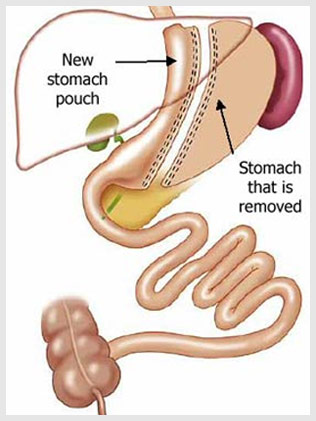Sleeve Gastrectomy

What is Sleeve Gastrectomy?
Sleeve gastrectomy also referred to as vertical sleeve, gastric sleeve or tube gastrectomy is a surgical procedure performed for the treatment of obesity. It encourages weight loss by restricting the stomach size, so it holds only a limited amount of food. This helps patients to eat less without hampering the normal digestive process. It also reduces the hunger sensation as the surgery also results in significant reduction in the production of hunger hormones.
What Happens During a Laparoscopic Sleeve Gastrectomy Procedure?
The procedure is performed under general anesthesia. The surgeon makes 4 to 5 small incisions on your abdomen. A laparoscope, a thin instrument with a light and camera attached, is inserted through one incision, allowing your surgeon to clearly view the internal organs on a monitor.
Additional surgical instruments are inserted through the other incisions. Your surgeon will remove nearly 75-80% of the stomach. A thin sleeve shaped like a banana is created by stapling the remaining part of the stomach. At the end of the procedure, the incisions are closed with sutures. The entire procedure takes about 60 to 90 minutes to complete.
Advantages of Sleeve Gastrectomy Surgery
- Reduced stomach volume increases the feeling of fullness
- Stomach functions normally allowing most foods to be eaten, just in smaller amounts
- Stomach portion that produces a hunger-stimulating hormone (Ghrelin) is removed.
- No dumping syndrome due to the pyloric portion of the stomach is left intact
- No intestinal bypass and its associated risks
- Can be performed laparoscopically
- Simpler procedure than gastric bypass
- Safer first stage procedure of two-stage surgery for super morbidly obese
- Less operative time than bypass surgeries
- Less hospital stays than bypass surgeries
- No foreign bodies used such as in-band surgery
Disadvantages of Sleeve Gastrectomy Surgery
Potential is higher for inadequate weight loss or weight regain compared to intestinal bypass surgeries.
- Irreversible
- Potential for dilation of the sleeve affecting weight loss
- May not be suitable for patients with severe reflux symptoms
Postoperative Care
- You would stay in hospital for 2-3 nights and are advised to have 2 weeks off work
- Your doctor will prescribe pain-relieving medications to keep you comfortable following the procedure
- You will be advised to take medication to reduce the amount of acid produced by your stomach
- Avoid strenuous exercises and lifting heavy weights until approved by your surgeon
- For the first month after the procedure, eat only small amounts of soft foods
- Sip water throughout the day to prevent dehydration
- Eat a highly nutritious diet rich in proteins with low-fat and carbohydrate content
- Your dietitian will tailor a new diet regimen for you to follow
Risks & Complications
As with any surgery, there are potential risks involved. The decision to proceed with the surgery is made because the advantages of surgery outweigh the potential disadvantages. It is important that you are informed of these risks before the surgery takes place. Most patients do not have complications after sleeve gastrectomy surgery; however, complications can occur and depend on the patient’s health status.
Complications can be medical (general) or specific to sleeve gastrectomy.
Medical complications include those of the anesthesia and your general wellbeing. Almost any medical condition can occur, so this list is not complete. Complications include:
- Allergic reaction to medications
- Blood loss requiring transfusion with its low risk of disease transmission
- Heart attack, strokes, kidney failure, pneumonia, bladder infections
- Complications from anesthesia
Serious medical problems can lead to ongoing health concerns, prolonged hospitalization, or rarely death. (less than 0.1% cases)
Specific complications for sleeve gastrectomy surgery include:
- DVT (blood clot in the deep leg veins)
- Damage to adjacent organs
- Leakage of digestive contents from the staple line can lead to serious infection (1%)
-
Sleeve Gastrectomy
Sleeve gastrectomy also referred to as vertical sleeve, gastric sleeve or tube gastrectomy is a surgical procedure performed for the treatment of obesity.
-
Gastric Bypass
Roux-en-Y gastric bypass (RYGB), commonly called simply "gastric bypass", is one of the most popularly performed bariatric procedures worldwide and has long been considered the "gold standard" of bariatric surgery.
-
Mini Gastric Bypass
The One Anastomosis Gastric Bypass (OAGB), also known as "mini-gastric bypass" was first reported in 2001. The OAGB is a minimally invasive procedure performed with laparoscopic technique.
-
Lap Band
In this procedure, a hollow band made of special material is placed around the stomach near its upper end, creating a small pouch and a narrow passage into the larger remainder of the stomach.
-
Intragastric Balloon (Orbera)
Gastric balloon, also called endoscopic intragastric balloon, is a non-surgical weight-loss procedure which involves the insertion of a specialized balloon inside the stomach to occupy space and limit the food carrying capacity of the stomach.
